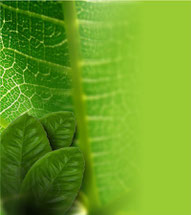Theme XVIII: Heterocycles
Chlorophyll. Structure and importance.
What is chlorophyll? Chlorophyll
structures and types. Chlorophyll a, b, c, d and e. Biological significance.
What is chlorophyll?
Chlorophyll is the substance that defines the green color of plants. Is in small elements called chloroplasts which are constituted by thin sheets that support larger structures, containing each one of them from 50 to 120 molecules of chlorophyll. Several of these structures are exclusively for photosynthesis, grouped into clusters of approximately 600 chlorophyll molecules.
Chlorophyll is concentrated particularly in the leaves of plants.
Constitutes the basis and source of life because through the photosynthesis are generated the primary compounds of all living organisms.
Chlorophyll structure
There are several different structures of chlorophyll, the most abundant is "chlorophyll a", likewise exist the b, c, d and e, accompanying the first at a proportion of one third. Their compositions are similar and have the same chemical properties.
“Chlorophyll a” is presented as a complex molecule comprising 55 carbon atoms, 72 hydrogen, 5 oxygen, 4 nitrogen and 1 of magnesium, therefore its formula is
C55H7205N4Mg.
Its structure consists of four pyrrole molecules bound as isocyclic ring (tetrapyrrole ring) at its center is linked one magnesium atom. In one of the pyrrole rings is
phytol, long chain alcohol of 23 carbons.

Chlorophyll structure
see also
Heterocyclic compounds
Pentagonal heterocyclic compounds with one heteroatom
Pyrrole
Porphyrin. Porphyrin ring
Hexagonal heterocyclic compounds: The Pyran and Pyrimidine
Pyrimidine ring
Indole, tryptophan, indole-3-acetic acid
Purine, uric acid, adenine, guanine.
Structure of nucleic acids

 Pharmacognosy´s topics - Medicinal plants
Pharmacognosy´s topics - Medicinal plants


Write a comment